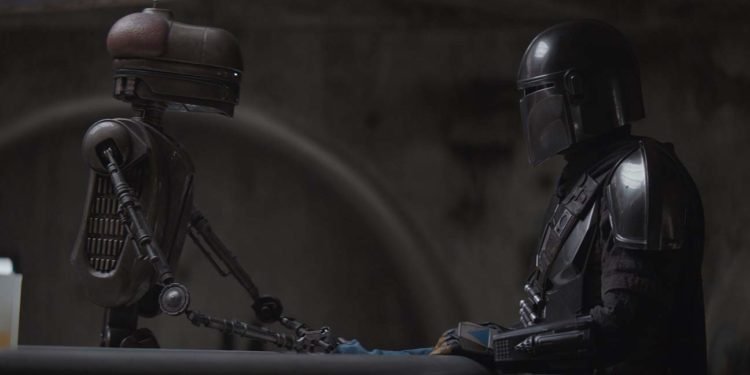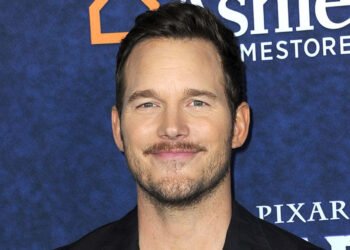“The Gunslinger” is the first time we’ve seen Tatooine within the Star Wars canon since Return of the Jedi (1983), though it does feature briefly in the novel Star Wars: Aftermath by Chuck Wendig, which takes place during the construction of the New Republic and mentions the power vacuum that emerged within criminal syndicates following the death of Jabba the Hutt. Even without Jabba or the Guild, Tatooine is very much the same as when we last saw it, with the biggest different being the bloody and battered stormtrooper helmets that line the entrance of a local cantina. It’s already been noted that the series goes the extra mile to pay its respects to George Lucas, and the while prequel films haven’t played much part in the sequel trilogy or Star Wars Story films, Filoni tips his hat to them by including the pit droids from The Phantom Menace (1999) and giving Mando a line about Mos Espa, home of podracing. But beyond visual cues and references, the episode has a number of parallels with The Phantom Menace and A New Hope, while ignoring the Jedi in the room.
The young bounty hunter applicant, Toro Callican (Jake Cannavale), looking to escape the mundanity of an ordinary life is of course reminiscent of the journeys of Anakin and Luke Skywalker. And he finds an older mentor in the Mandalorian, just as Anakin found one in Qui-Gon Jinn and Luke in Ben Kenobi. And while there’s no princess to rescue, there is a masked villain, Fennec Shand (Ming-Na Wen), who seems like quite the adversary for the scale of this series. But as the episode shows, there’s little room for grand gestures of heroism because few seem to see it as an option. While Anakin Skywalker becoming Darth Vader isn’t common knowledge across the galaxy, one would think the exploits of Luke Skywalker would be pretty famous. There’s a natural expectation for Luke to get a namedrop in this episode, or at least a coy reference. But there are none. Sure, Tatooine is a big planet, and Mando isn’t exactly hanging out in Luke’s old haunts, Tosche Station, or Mos Eisley. But one would think, given the lack of excitement and adventure on Tatooine, that a resident who left, became a Jedi, and destroyed the Empire would be a bigger deal. But it isn’t, at least in terms of where this episode stands. As such, the most heroic thing to do is capture a bounty, regardless of their deed, and get paid for it in credits and status.
The lack of a reference to Luke really puts his place in the galaxy into perspective. Because the character is a cultural icon, fans have long viewed him as a superhuman, or even religious figure. But in terms of the galaxy, he is so far removed from the lives and ordinary concerns of the people on the ground-level which The Mandalorian is most interested in, that he might as well be a fairy tale. For Toro, becoming a legend means becoming a bounty hunter, because that’s the highest level of success imaginable and attainable for someone on the Outer Rim. And the moral code of the Jedi seems just as fictitious. Through a series of double-crosses we learn that Toro isn’t destined for heroism like Anakin or Luke were, but unremarkable criminality on an unremarkable world. His characterization, eager, brash, frustrated with his own place in the world is so reminiscent of Anakin and Luke that he serves as a reminder of what lives might have been in store for them had they not been burdened with a larger destiny.
In The Force Awakens, Luke Skywalker and the Jedi are seen as a myth by Rey on Jakku, which has its own similarities to Tatooine. It seems odd that in the 30 years since the Galactic Civil War that Luke Skywalker would have become the equivalent to Gilgamesh or Hercules, even if he had spent some of those years in hiding. But “The Gunslinger” shows exactly how Skywalker could have faded so easily into myth, because the idea of a boy from the Outer Rim becoming a hero is too far out there to be a reality in the distant corners of the galaxy. Perhaps that’s the biggest failing of the New Republic and Luke Skywalker in terms of building the future of the galaxy. Their hope was insular, and only traveled so far, and where it didn’t, such notions became a fantasy. This only serves to add greater significance to Luke’s sacrifice at the end of The Last Jedi (2017), igniting the spark of the Resistance so that it travels further than it did before, inspiring a young stablehand on a backwater planet to consider becoming a Jedi, rather than a potential bounty hunter.
With five episodes in the can, The Mandalorian has succeeded through the beautiful simplicity of its samurai and western inspired stories. But there’s complexity in the details, the references made, and the lives of the supporting characters that give a greater context to the Star Wars franchise, and the events of the sequel trilogy. The original trilogy may have been about an age of heroes, but at the edges of the galaxy, heroism is in short supply, which makes the moral journey of the Mandalorian all the more important.
























































